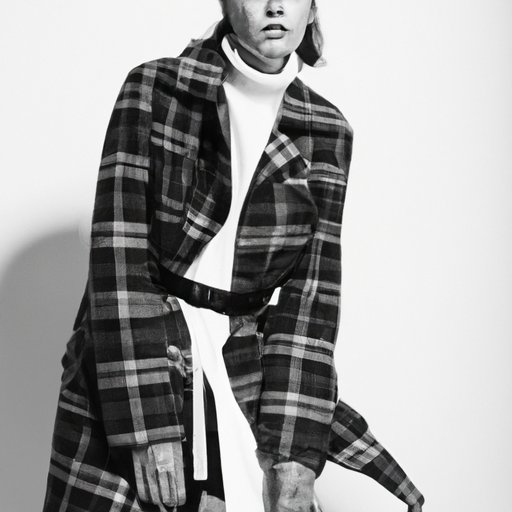Introduction
Fashion editorials are photo stories that feature models wearing clothes from a particular designer or brand. They are used to promote clothing and accessories collections, as well as to showcase the latest trends in fashion. The purpose of this article is to explore the role of a fashion editor in the making of an editorial, different types of fashion editorials, how to create an effective one, and examples of notable fashion editorials.

The Role of a Fashion Editor in the Making of an Editorial
A fashion editor is responsible for overseeing the creation of a fashion editorial. They collaborate with photographers, stylists, makeup artists, and other creatives to bring the concept to life. The fashion editor is the driving force behind the editorial – they are the ones who come up with the theme, select the clothes and accessories, and create the overall look and feel.
A fashion editor can shape an editorial in many ways. They decide which models to use, the location of the shoot, the poses and expressions of the models, and the lighting. They also oversee the styling process and make sure that the clothes and accessories chosen for the editorial are in line with the theme. Finally, they work closely with the photographer to ensure that the final images look professional and reflect the vision of the editorial.
Exploring Different Types of Fashion Editorials
There are several different types of fashion editorials. Magazine fashion editorials are usually featured in print publications such as Vogue, Elle, and Harper’s Bazaar. These editorials are often quite elaborate and feature high-end fashion brands. Online fashion editorials are usually seen on websites such as Style.com and Refinery29. They tend to be more accessible than magazine editorials, as they are often less expensive to produce and can reach a wider audience.
Ad campaigns are another type of fashion editorial. These are typically created by fashion brands to promote their collections. Ad campaigns can be seen in magazines, on billboards, and on social media. They tend to be very creative and focus on the products being promoted.

How to Create an Effective Fashion Editorial
Creating an effective fashion editorial requires careful planning and attention to detail. The first step is to identify the target audience. This will help you determine the overall look and feel of the editorial, as well as the type of clothes and accessories to be featured. Once the target audience has been identified, it is important to choose the right team. This includes a photographer, stylist, makeup artist, and model(s).
The next step is to select the right clothes and accessories. This should be done in accordance with the theme of the editorial and the target audience. The clothes and accessories should be carefully curated to ensure that they fit the overall look and feel of the editorial. It is also important to establish the overall look and feel of the editorial. This includes the setting, background, props, and other elements that will contribute to the aesthetics of the shoot.
Examples of Notable Fashion Editorials
Vogue is one of the most iconic fashion magazines in the world. Its fashion editorials are known for pushing the boundaries and featuring some of the most iconic images ever captured. Elle is another well-known fashion magazine that produces stunning editorials every month. Harper’s Bazaar is another magazine that creates beautiful editorial images. Their editorials are often highly conceptual and feature some of the biggest names in fashion.
The Benefits of Creating Fashion Editorials
Creating fashion editorials can be beneficial for a variety of reasons. Firstly, it can increase visibility for a brand or designer. By producing high-quality images that capture the essence of their collections, they can gain more exposure and recognition. Secondly, creating fashion editorials can help to improve brand recognition. People who see the images will become familiar with the brand and its products. Finally, creating fashion editorials can enhance credibility. By producing professional images that showcase the quality of their products, designers and brands can gain more respect in the industry.

The Future of Fashion Editorials
The future of fashion editorials looks bright. As technology advances, so does the way we create and consume fashion content. Social media platforms like Instagram and Snapchat have allowed fashion brands to create and share content in new and innovative ways. Digital platforms such as YouTube and TikTok have also opened up new opportunities for fashion brands to reach a larger audience. Finally, augmented reality has enabled fashion brands to create immersive experiences that allow customers to try on clothes without actually having to do so.
Conclusion
Fashion editorials are an important part of the fashion industry. They are used to promote clothing and accessories collections, as well as to showcase the latest trends in fashion. A fashion editor plays a key role in the making of an editorial and is responsible for selecting the clothes and accessories, establishing the overall look and feel, and collaborating with other creatives to bring the concept to life. There are several different types of fashion editorials, including magazine, online, and ad campaigns. Creating an effective fashion editorial requires careful planning and attention to detail. There are numerous benefits to creating fashion editorials, including increased visibility, improved brand recognition, and enhanced credibility. As technology advances, so does the way we create and consume fashion content, and the future of fashion editorials looks brighter than ever before.
(Note: Is this article not meeting your expectations? Do you have knowledge or insights to share? Unlock new opportunities and expand your reach by joining our authors team. Click Registration to join us and share your expertise with our readers.)
